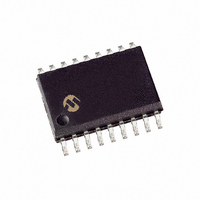MCP2515-I/SO Microchip Technology, MCP2515-I/SO Datasheet - Page 49

MCP2515-I/SO
Manufacturer Part Number
MCP2515-I/SO
Description
IC CAN CONTROLLER W/SPI 18SOIC
Manufacturer
Microchip Technology
Specifications of MCP2515-I/SO
Package / Case
18-SOIC (7.5mm Width)
Controller Type
CAN Interface
Interface
SPI
Voltage - Supply
2.7 V ~ 5.5 V
Current - Supply
10mA
Operating Temperature
-40°C ~ 85°C
Mounting Type
Surface Mount
Product
Controller Area Network (CAN)
Number Of Transceivers
1
Data Rate
1 Mbps
Supply Voltage (max)
5.5 V
Supply Voltage (min)
2.7 V
Supply Current (max)
10 mA
Maximum Operating Temperature
+ 85 C
Minimum Operating Temperature
- 40 C
Mounting Style
SMD/SMT
Supply Voltage Range
2.7V To 5.5V
Driver Case Style
SOIC
No. Of Pins
18
Operating Temperature Range
-40°C To +85°C
Filter Terminals
SMD
Supply Voltage Min
2.7V
Rohs Compliant
Yes
Clock Frequency
40MHz
Lead Free Status / RoHS Status
Lead free / RoHS Compliant
For Use With
MCP2515DM-BM - BOARD DEMO FOR MCP2515/51MCP2515DM-PTPLS - BOARD DAUGHTER PICTAIL MCP2515MCP2515DM-PCTL - BOARD DEMO FOR MCP2515DV251001 - KIT DEVELOPMENT CAN MCP2510
Lead Free Status / Rohs Status
Lead free / RoHS Compliant
Available stocks
Company
Part Number
Manufacturer
Quantity
Price
Company:
Part Number:
MCP2515-I/SO
Manufacturer:
TI
Quantity:
1 000
Part Number:
MCP2515-I/SO
Manufacturer:
MICROCHIP/微芯
Quantity:
20 000
7.0
The MCP2515 has eight sources of interrupts. The
CANINTE register contains the individual interrupt
enable bits for each interrupt source. The CANINTF
register contains the corresponding interrupt flag bit for
each interrupt source. When an interrupt occurs, the
INT pin is driven low by the MCP2515 and will remain
low until the interrupt is cleared by the MCU. An
interrupt can not be cleared if the respective condition
still prevails.
It is recommended that the bit modify command be
used to reset flag bits in the CANINTF register rather
than normal write operations. This is done to prevent
unintentionally changing a flag that changes during the
write command, potentially causing an interrupt to be
missed.
It should be noted that the CANINTF flags are
read/write and an interrupt can be generated by the
MCU setting any of these bits, provided the associated
CANINTE bit is also set.
7.1
The source of a pending interrupt is indicated in the
CANSTAT.ICOD (interrupt code) bits, as indicated in
Register 10-2. In the event that multiple interrupts
occur, the INT will remain low until all interrupts have
been reset by the MCU. The CANSTAT.ICOD bits will
reflect the code for the highest priority interrupt that is
currently pending. Interrupts are internally prioritized
such that the lower the ICOD value, the higher the
interrupt priority. Once the highest priority interrupt
condition has been cleared, the code for the next
highest priority interrupt that is pending (if any) will be
reflected by the ICOD bits (see
interrupt sources that have their associated CANINTE
enable bit set will be reflected in the ICOD bits.
TABLE 7-1:
© 2010 Microchip Technology Inc.
ICOD<2:0>
Note:
000
001
010
011
100
101
110
111
INTERRUPTS
Interrupt Code Bits
ERR is associated with CANINTE,ERRIE.
ERR•WAK•TX0•TX1•TX2•RX0•RX1
ERR
ERR•WAK
ERR•WAK•TX0
ERR•WAK•TX0•TX1
ERR•WAK•TX0•TX1•TX2
ERR•WAK•TX0•TX1•TX2•RX0
ERR•WAK•TX0•TX1•TX2•RX0•RX1
ICOD<2:0> DECODE
Boolean Expression
Table
7-1). Only those
7.2
When
(CANINTE.TXnIE = 1), an interrupt will be generated on
the INT pin once the associated transmit buffer
becomes empty and is ready to be loaded with a new
message. The CANINTF.TXnIF bit will be set to indicate
the source of the interrupt. The interrupt is cleared by
clearing the TXnIF bit.
7.3
When
(CANINTE.RXnIE = 1), an interrupt will be generated
on the INT pin once a message has been successfully
received and loaded into the associated receive buffer.
This interrupt is activated immediately after receiving
the EOF field. The CANINTF.RXnIF bit will be set to
indicate the source of the interrupt. The interrupt is
cleared by clearing the RXnIF bit.
7.4
When an error occurs during the transmission or
reception of a message, the message error flag
(CANINTF.MERRF)
CANINTE.MERRE bit is set, an interrupt will be
generated on the INT pin. This is intended to be used
to facilitate baud rate determination when used in
conjunction with Listen-only mode.
7.5
When the MCP2515 is in Sleep mode and the bus activ-
ity wakeup interrupt is enabled (CANINTE.WAKIE = 1),
an interrupt will be generated on the INT pin and the
CANINTF.WAKIF bit will be set when activity is detected
on the CAN bus. This interrupt causes the MCP2515 to
exit Sleep mode. The interrupt is reset by clearing the
WAKIF bit.
7.6
When
(CANINTE.ERRIE = 1), an interrupt is generated on
the INT pin if an overflow condition occurs or if the error
state of the transmitter or receiver has changed. The
Error Flag (EFLG) register will indicate one of the
following conditions.
7.6.1
An overflow condition occurs when the MAB has
assembled a valid receive message (the message
meets the criteria of the acceptance filters) and the
receive buffer associated with the filter is not available
for loading of a new message. The associated
EFLG.RXnOVR bit will be set to indicate the overflow
condition. This bit must be cleared by the MCU.
Note:
Transmit Interrupt
Receive Interrupt
Message Error Interrupt
Bus Activity Wakeup Interrupt
Error Interrupt
the
the
the
The MCP2515 wakes up into Listen-only
mode.
RECEIVER OVERFLOW
transmit
receive
error
will
interrupt
interrupt
be
interrupt
MCP2515
set
DS21801F-page 49
and,
is
is
is
enabled
enabled
enabled
if
the
















